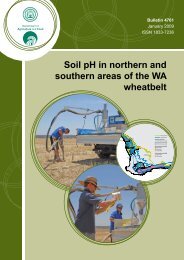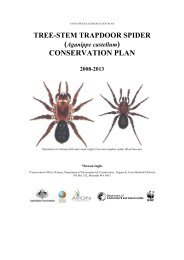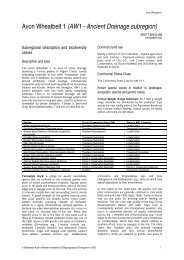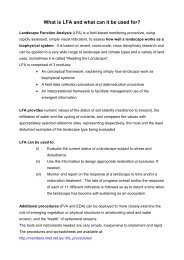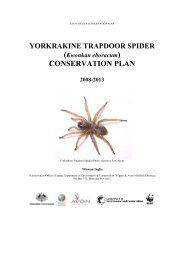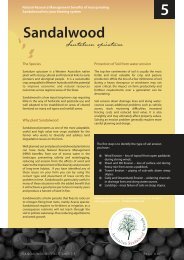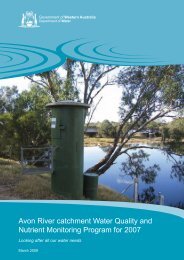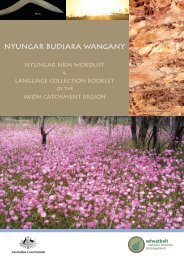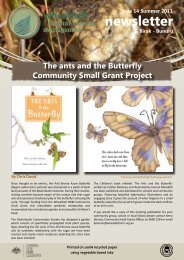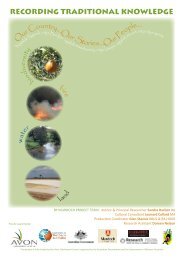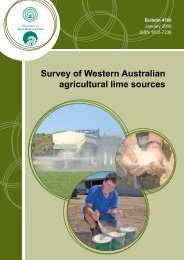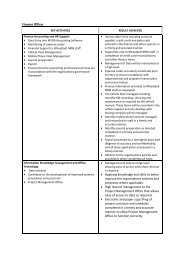Kokerbin Nature Reserve Desktop Fauna ... - Wheatbelt NRM
Kokerbin Nature Reserve Desktop Fauna ... - Wheatbelt NRM
Kokerbin Nature Reserve Desktop Fauna ... - Wheatbelt NRM
Create successful ePaper yourself
Turn your PDF publications into a flip-book with our unique Google optimized e-Paper software.
<strong>Kokerbin</strong> <strong>Nature</strong> <strong>Reserve</strong><br />
<strong>Desktop</strong> <strong>Fauna</strong> Assessment<br />
Beecham (2001) describes the Avon <strong>Wheatbelt</strong> as a gently undulating landscape of<br />
low relief. Vegetation is dominated by:<br />
- Proteaceous scrubheaths, rich in endemics, on residual lateritic uplands and<br />
derived sandplains;<br />
- mixed eucalypt, Allocasuarina huegeliana and Jam-York Gum woodlands on<br />
Quaternary alluvials and eluvials.<br />
The Ancient Drainage subregion is an ancient peneplain with low relief, gently<br />
undulating and has no connected drainage. Salt lake chains occur as remnants of<br />
ancient drainage systems that now only function in very wet years (Beecham, 2001).<br />
Lateritic uplands are dominated by areas of yellow sandplain. The region has a<br />
climate described as semi-arid (Dry) Warm Mediterranean with a total area of<br />
6,566,022 ha.<br />
The dominant land use in this subregion is cultivation (dryland agriculture) and<br />
grazing (improved pastures and dryland), with smaller areas of Unallocated Crown<br />
Land and Crown reserves, conservation areas, rural residential and mining.<br />
A number of Critical Weight Range Mammals (35-7 000 g weight range mammals)<br />
have declined in the Avon <strong>Wheatbelt</strong> region and are threatened by cat (both feral and<br />
domestic) and fox predation. Two species are now considered nationally extinct (the<br />
Pig-footed Bandicoot and Crescent Nailtail Wallaby). Several species are locally<br />
extinct, while many others occur in small, isolated and fragmented distributions (see<br />
Appendix 1). Beecham lists a number of conservation significant fauna species<br />
recorded in the Ancient Drainage Subregion. These include(with DEC conservation<br />
status categories):<br />
• Red-tailed Phascogale (Phascogale calura), Endangered<br />
• Black-flanked Rock Wallaby (Petrogale lateralis lateralis), Vulnerable<br />
• Carnaby's cockatoo (Calyptorhynchus latirostris), Endangered<br />
• Malleefowl (Leipoa ocellata), Vulnerable<br />
• Western Spiny-tailed Skink (Egernia stokesii badia), Endangered<br />
• Slender-billed Thornbill (Acanthiza iredalei), Vulnerable<br />
• Shield-backed Trapdoor Spider (Idiosoma nigrum), Schedule 1<br />
• Kwonkan eboracum (a trapdoor spider), Schedule 1<br />
• Teyl sp. (BY Main 195312683, 1984/13) (a trapdoor spider), Schedule 1<br />
• Peregrine Falcon (Falco peregrinus) , Schedule 4<br />
• Carpet Python (Morelia spilota imbricata), Schedule 4<br />
• Woma (Aspidites ramsayi, south west population), Schedule 4<br />
• Western Rosella (Inland subspecies, Platycercus icterotis xanthogenys)<br />
Priority 2<br />
• Barking Owl (Southwest, Ninox connivens connivens), Priority 2<br />
• Lerista viduata, Priority 1<br />
• Daphnia jollyi, Priority 1<br />
• Limnocythere porphyretica, Priority 1<br />
Granite Outcrops are recognised as a significant fauna habitat in the region providing<br />
seasonal resources and temporary refuge for local fauna. A number of conservation<br />
6



